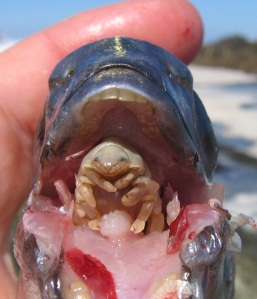Just giving my share for this very nice thread.
I'm not sure if it's the top of it's category but this parasite is definitely disgusting.
The Dragon Worm
The Guinea worm, or Dracunculus, meaning ‘little dragon’ in Latin, is caught by drinking dirty water containing tiny water fleas infected with larvae. Once inside someone, the spaghetti-like female worm grows up to a metre long and emerges through the skin, usually on the legs or feet, causing a burning pain that inspired the parasite’s name. The pain can last for weeks and there’s no vaccine – the only way to get the worm out is to gradually wrap it around a stick.
Results 141 to 150 of 259
-
11-04-2010, 03:02 PM #141
-
11-04-2010, 03:51 PM #142
wew .... hehe mka goosbumps .... mura sad cyag ring worm ..
pero gikan sa intestine , mu-agi diay ni sa viens to the skin .... aw
-
11-04-2010, 08:08 PM #143
i've also read about that worm. it's rampant in Africa kay wala bayay limpyo nga tubig didto.
it's really creeeeepy!
-
11-04-2010, 08:41 PM #144
A much detailed visuals about the Dragon Worm (Dracunculus medinensis)
Check this link:
YouTube - Eradicating Guinea Worm Disease: Taming the "Fiery Serpent" (The Carter Center)
Geeez.....I'm never gonna eat noodles again
-
11-04-2010, 09:34 PM #145
Meet the longest cat ever.

"Oct. 21, 2010 -- This 5-year-old Maine Coon cat, named Stewie, has claimed the Guinness World Record as the world's longest domestic cat, measuring in at more than 4 feet.
Robin Hendrickson, seen here holding Stewie, and her husband are the owners of the feline. She contacted Guinness World Records after repeatedly hearing friends and neighbors comment on Stewie's length.
The official Guinness measurement pegs Stewie at 48.5 inches from the tip of his tail to his nose. The previous record-holder was also a Maine Coon cat."
Source: Meet the Longest Cat Ever: Big Pic : Discovery News
-
11-08-2010, 07:46 AM #146
-
11-09-2010, 01:29 PM #147
-
11-12-2010, 07:06 AM #148
Check this out guys:
Tongue-Eating parasitic louse (Cymothoa exigua)




Cymothoa exigua, or the tongue-eating louse, is a parasitic crustacean of the family Cymothoidae. It tends to be 3 to 4 centimetres (1.2 to 1.6 in) long. This parasite enters through the gills, and then attaches itself at the base of the host fishes' tongue. It extracts blood through the claws on its front, causing the tongue to atrophy & shrink from lack of blood. The parasite then replaces the fish's tongue by attaching its own body to the muscles of the tongue stub. The fish is able to use the parasite just like a normal tongue. It appears that the parasite does not cause any other damage to the host fish. Once C. exigua replaces the tongue, some feed on the host's blood and many others feed on fish mucus. This is the only known case of a parasite functionally replacing a host organ. It is currently believed that C. exigua are not harmful to humans unless picked up alive, in which case they can bite.
There are many species of Cymothoa, but only C. exigua is known to consume and replace its host's tongue.
-
11-12-2010, 09:56 AM #149
-
11-12-2010, 02:02 PM #150
Advertisement
Similar Threads |
|










 Reply With Quote
Reply With Quote




